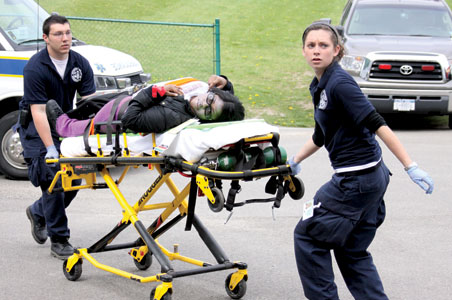
A buzz fills the air as a female student is rushed in by Harpur’s Ferry. She lies on a stretcher with facial lacerations and a fractured wrist. A nurse emerges from the floor of the Events Center, reads off her triage tag and immediately sends her off to the burn care unit.
Amidst the number of local news crews, stretchers and medical personnel, there is a sense of calm and structured urgency. The patients they are treating have just come from an explosion in Binghamton University’s Physical Facilities, or so it seems.
These events are actually occurring at the annual disaster drill held by the Decker School of Nursing in conjunction with the American Red Cross, Vestal Emergency Medical Services, Metropolitan Emergency response team, Harpur’s Ferry and Binghamton’s New York State University Police. This required drill is held to prepare BU nursing students for the worst to come.
“I think it’s really helpful, because for disaster planning you need to know how the triage system works,” Caitlin Burchill, a senior nursing student, said. “It’s pretty realistic.”
Burchill is a floating nurse who has had training at several different hospitals. She could be found busily tending to patients in transport, the burn unit and the triage.
Steven Korona, an accelerated nursing student, is moving from unit to unit on the stadium floor. He represents Safety and Communications on the command staff for the drill.
“We want the nurses to stay in their own units, to ensure that patients are treated with maximum efficiency,” he said. “My task is to ensure the safety of the site and the staff, which are all the nurses and volunteers.”
Shortly after, a second explosion occurs. The patients that flood in now suffer from diesel contamination in addition to dementia and fractures. A decontamination tent is opened for the new patients.
“We are simulating a propane explosion and a secondary diesel fuel explosion,” said Margaret Contro, the clinical faculty adviser for the Decker School of Nursing.
According to Alexandra Karlgut, a senior student nurse disaster drill liaison, all of the patients involved are volunteers.
“I have burns on 45 percent of my body, arms and legs,” says Roger Jones, a Boy Scout volunteer trying to earn a merit badge, as he is being treated in the burn ward. He is one of many volunteers for the disaster drill.
Patients that do not suffer from serious injuries are directed toward the Red Cross tent.
“This is the fourth year we have been involved in this drill,” said Jason Davis of the Red Cross Foundation’s Southern Tier chapter. “Depending on the disaster, we have different facilities that would be designated. In general, we plan ahead of the hazards. Every year it’s one of the best drills we have.”
Laura Kasey, coordinator of the Decker Disaster Drill, claims that these drills have better prepared the University and the community for future disasters.
“I think we’re much better prepared than we were 10 years ago,” she said. “We’ve improved on our ability to integrate activities, like the University police and emergency medical services.”
With the recent hysteria surrounding the H1N1 (Swine Flu) virus, a discussion at the drill covered what the University and surrounding areas would do in the case of a viral outbreak on campus.
“We are doing a lot of emergency planning, and we do it as a team,” Kasey said. “The question of how we prepare a county for a swine flu outbreak is particularly important for the graduate group. We would have the community, EMS and the county public health department come in.”
Diane O’Hara, spokesperson for the Broome County Health Department, said that if there were a swine-flu outbreak, the University Health Services would “contact the Broome County Health department based on the information a student gave, and we would determine what to do from there.”
“We would check all close contacts of the students through contact-tracing if we felt the student met all of the suspect cases,” she said.
Each year, a new disaster drill is planned by senior nursing students. Last year, students were caring for patients displaced by a tornado.


